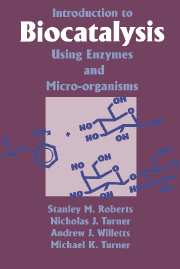Book contents
- Frontmatter
- Contents
- Preface
- Abbreviations
- 1 An historical introduction to biocatalysis using enzymes and micro-organisms
- 2 The interrelationships between enzymes and cells, with particular reference to whole-cell biotransformations using bacteria and fungi
- 3 Useful intermediates and end-products obtained from whole-cell/enzyme-catalysed hydrolysis and esterification reactions
- 4 Useful intermediates and end-products obtained from biocatalysed oxidation and reduction reactions
- 5 Useful intermediates and end-products obtained from biocatalysed carbon–carbon, carbon–oxygen, carbonnitrogen and carbon–chalcogen bond-forming reactions
- 6 The application of biocatalysis to the manufacture of fine chemicals
- Index
5 - Useful intermediates and end-products obtained from biocatalysed carbon–carbon, carbon–oxygen, carbonnitrogen and carbon–chalcogen bond-forming reactions
Published online by Cambridge University Press: 04 August 2010
- Frontmatter
- Contents
- Preface
- Abbreviations
- 1 An historical introduction to biocatalysis using enzymes and micro-organisms
- 2 The interrelationships between enzymes and cells, with particular reference to whole-cell biotransformations using bacteria and fungi
- 3 Useful intermediates and end-products obtained from whole-cell/enzyme-catalysed hydrolysis and esterification reactions
- 4 Useful intermediates and end-products obtained from biocatalysed oxidation and reduction reactions
- 5 Useful intermediates and end-products obtained from biocatalysed carbon–carbon, carbon–oxygen, carbonnitrogen and carbon–chalcogen bond-forming reactions
- 6 The application of biocatalysis to the manufacture of fine chemicals
- Index
Summary
Introduction
This chapter deals with three important classes of biotransformations. Firstly, those enzymes that catalyse the stereoselective formation of carbon-carbon bonds will be examined. These enzymes, whose natural functions often are to degrade carbohydrate-like molecules, have proved to be versatile catalysts for C—C bond synthesis. Secondly, we shall look at those enzymes that mediate the formation of C—X bonds, where X = O, N, S, Hal (halogen). These enzymes are termed lyases (see Table 2.1) and often carry out very simple reactions (e.g. the addition of water to a double bond) with very high stereoselectivity and regioselectivity. Finally, the application of a range of enzymes (including C—C bond formation) to carbohydrate synthesis will be examined. This chapter will conclude with some examples of the ways in which multienzyme reactions can be constructed to enable highly complex molecules to be assembled in an efficient manner.
Enzyme–catalysed asymmetric carbon–carbon bond formation
Aldolases
The synthesis of carbon–carbon bonds, particularly with control of stereochemistry, has been an area of intense activity in recent years. Much attention has been focussed on the asymmetric aldol reaction, principally using stoichiometric quantities of a chiral auxiliary, but more recently in the catalytic mode. The use of aldolases for the asymmetric construction of carbon-carbon bonds presents a potentially useful complementary methodology.
The aldolases are a diverse class of enzymes that catalyse the coupling of a carbonyl-containing compound (nucleophile), containing one, two or three carbons, with an aldehyde (electrophile). In most cases the nucleophile is either pyruvic acid or dihydroxyacetone phosphate, whereas the electrophilic aldehyde is much more variable in structure.
- Type
- Chapter
- Information
- Introduction to Biocatalysis Using Enzymes and Microorganisms , pp. 118 - 139Publisher: Cambridge University PressPrint publication year: 1995



